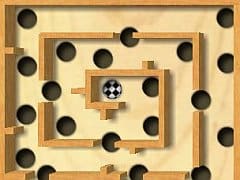Video Gamer is reader-supported. When you buy through links on our site, we may earn an affiliate commission. Prices subject to change. Learn more
Patience is a virtue and it’s a virtue that you had better be familiar with if you want to find yourself coming out of playing Labyrinth with your iPhone intact. Illusion Labs’ puzzler is not only fiendishly addictive, it’s also devilishly frustrating.
Labyrinth is based on a traditional children’s toy that involves guiding a steel marble around a wooden maze by tilting the x and y-axes. Chances are you’ve played on one in the past, but even if you haven’t the digital incarnation of labyrinth is as straightforward and as easy to pick up as its traditional cousin, which is exactly the reason why it’s so enjoyable to play.
Controls are handled entirely through tilting, making it a unique experience to the Apple handheld. When the iPhone is held parallel to the floor the slightest tilt left, right, up or down will send the on-screen ball rolling in the appropriate direction. The accelerometer controls are so precise that it really does feel like you’re rolling a miniature ball around inside your iPhone. It’s hard to think of a more perfect example of how the accelerometer can successfully be applied to the design of a game – it’s that good.
The huge number of mazes in Labyrinth are supplied by the players themselves via a website-based level editor. Sadly there are no level editing options within the game itself; it would have been nice to have had the option to create and upload levels on the go. Still, with over 1000 levels at your disposal (with more becoming available through regular updates) there is plenty to keep you going while you dream up even more patience testing quandaries.
Sadly Labyrinth has a big flaw and that’s its lack of flexibility. The game has to be played with the iPod/iPhone parallel to the floor meaning it’s nigh on impossible to play the game while reclining. The game does offer some calibration options but it’s clear that this is a game to be played while sitting or standing and not lying down or slouching in your favourite armchair.
Labyrinth is still the finest example of how the iPhone’s accelerometer works and if you can get over the fact you’ll never be able to play it in bed then you should definitely check out this patience-testing puzzler.

/https://oimg.videogamer.com/images/b46c/labyrinth_3.jpg)